 W
WThe Académie Royale d'Architecture was a French learned society founded in 1671. It had a leading role in influencing architectural theory and education, not only in France, but throughout Europe and the Americas from the late 17th century to the mid-20th.
 W
WJacques Denis Antoine was a French architect. His masterwork is the Hôtel des Monnaies in Paris, which gained him entrance to the Académie royale d'architecture in 1776. He is also known for his work for private castle, like the Château of Buisson de May, in Normandy made from 1781 to 1783 just before the french revolution. His favourite style was the neoclassic architecture.
 W
WJean Beausire was an architect, engineer and fountain-maker and the chief of public works in Paris for King Louis XIV of France and King Louis XV of France between 1684 and 1740, and was the architect of all the public fountains constructed in Paris that period. Several of his fountains still exist and continue to work. Three streets in the 4th arrondissement of Paris today carry his name: Rue Jean-Beausire, Impasse Jean-Beausire, and Passage Jean-Beausire.
 W
WFrançois Blondel was a soldier, engineer of fortifications, mathematician, diplomat, military and civil engineer and architect, called "the Great Blondel", to distinguish him in a dynasty of French architects. He is remembered for his Cours d'architecture which remained a central text for over a century. His precepts placed him in opposition with Claude Perrault in the larger culture war known under the heading Querelle des anciens et des modernes. If François Blondel was not the most highly reputed among the académiciens of his day, his were the writings that most generally circulated among the general public, the Cours de Mathématiques, the Art de jetter les Bombes, the Nouvelle manière de fortifier les places and, above all his Cours d'Architecture.
 W
WJacques-François Blondel was an 18th-century French architect and teacher. After running his own highly successful school of architecture for many years, he was appointed Professor of Architecture at the Académie Royale d'Architecture in 1762, and his Cours d'architecture largely superseded a similarly titled book published in 1675 by his famous namesake, François Blondel, who had occupied the same post in the late 17th century.
 W
WGermain Boffrand was a French architect. A pupil of Jules Hardouin-Mansart, Germain Boffrand was one of the main creators of the precursor to Rococo called the style Régence, and in his interiors, of the Rococo itself. In his exteriors he held to a monumental Late Baroque classicism with some innovations in spatial planning that were exceptional in France His major commissions, culminating in his interiors at the Hôtel de Soubise, were memorialised in his treatise Livre d'architecture, published in 1745, which served to disseminate the French Louis XV style throughout Europe.
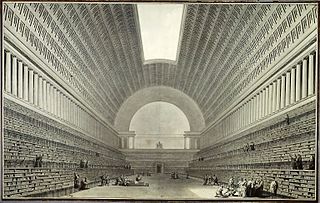 W
WÉtienne-Louis Boullée was a visionary French neoclassical architect whose work greatly influenced contemporary architects.
 W
WAlexandre-Théodore Brongniart was a prominent French architect.
 W
WLibéral Bruant, was a French architect best known as the designer of the Hôtel des Invalides, Paris, which is now dominated by the dome erected by Jules Hardouin Mansart, his collaborator in earlier stages of the construction. A comparison of Bruant's central entrance to the Invalides, under an arched cornice packed with military trophies with Mansart's Église du Dome, gives a clear idea of the difference between Bruant's High Baroque and Hardouin-Mansart's restrained and somewhat academic Late Baroque.
 W
WPierre Bullet was a French architect. He was one of the students of François Blondel.
 W
WCharles Étienne Louis Camus, was a French mathematician and mechanician who was born at Crécy-en-Brie, near Meaux.
 W
WJean-François-Thérèse Chalgrin was a French architect, best known for his design for the Arc de Triomphe, Paris.
 W
WJean-Michel Chevotet was a French architect. He and Pierre Contant d'Ivry were among the most eminent Parisian architects of the day and designed in both the restrained French Rococo manner, known as the "Louis XV style" and in the "Goût grec" phase of early Neoclassicism. His grandson was Pierre-Jean-Baptiste Chaussard.
 W
WPierre Contant d'Ivry, was a French architect and designer working in a chaste and sober Rococo style and in the goût grec phase of early Neoclassicism.
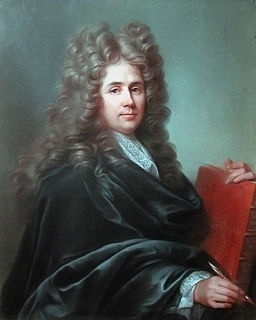 W
WRobert de Cotte was a French architect-administrator, under whose design control of the royal buildings of France from 1699, the earliest notes presaging the Rococo style were introduced. First a pupil of Jules Hardouin-Mansart, he later became his brother-in-law and his collaborator. After Hardouin-Mansart's death, de Cotte completed his unfinished projects, notably the royal chapel at Versailles and the Grand Trianon.
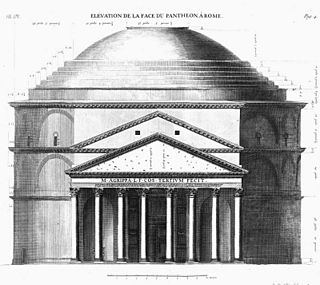 W
WAntoine Babuty Desgodetz's (1653–1728) publication Les edifices antiques de Rome dessinés et mesurés très exactement provided detailed engravings of the monuments and antiquities of Rome to serve French artists and architects. Desgodetz had been sent to Rome in an official capacity, part of French architectural and artistic policy, and the engravings for his publication were supervised by Jean-Baptiste Colbert, according to Desgodetz' introduction. The young architect with a copy of Les edifices antiques de Rome could determine the precise proportions of many Roman structures, such as the portico of the Pantheon, or the Temple of Vesta, Tivoli, that were considered the best models, a practice that had the effect of standardizing the details of academic architecture in France. His Edifices antiques was reissued in Paris, 1729 and again in 1779, when it proved as helpful to Neoclassical architects as it had been to classicizing Late Baroque ones. The young Robert Adam toyed with the idea of producing a revised version of Desgodetz before he hit on the idea of striking into fresh territory with measured engravings of the ruins of Diocletian's palace at Spalatro.
 W
WClaude Desgots was a French architect and landscape architect, who designed French formal gardens in France and England. He worked with and was strongly influenced by André Le Nôtre, the designer of the gardens at Vaux-le-Vicomte and Versailles that set the pattern for grand gardening in France up to the Revolution. In spite of increasing competition from the informal English landscape style, the French tradition was kept vital through apprenticeship connections in the generation following Le Nôtre's death in 1700, and a principal representative in this tradition was Claude Desgots, "a worthy heir and a great talent in gardening", remarked the master teacher of architecture Jacques-François Blondel.
 W
WAndré Félibien, sieur des Avaux et de Javercy, was a French chronicler of the arts and official court historian to Louis XIV of France.
 W
WAnge-Jacques Gabriel was the principal architect of King Louis XV of France. His major works included the Place de la Concorde, the École Militaire, and the Petit Trianon and opera theater at the Palace of Versailles. His style was a careful balance between French Baroque architecture and French neoclassicism.
 W
WJacques Gabriel (1667–1742) was a French architect, the father of the famous Ange-Jacques Gabriel. Jacques Gabriel was a designer, painter and architect of the 17th and 18th centuries and one of the most prominent designers of the Versailles Palace in his lifetime. For his unique creativity and selflessness, he was always attended by Louis XIV and eventually became a trusted advisor to the monarch. He made important contributions to him during his years of service of which the construction of the Versailles palace was the most important.
 W
WDaniel Gittard was a French architect.
 W
WJacques Gondouin de Folleville, or simply Gondoin was a French architect and designer.
 W
WCharles-Axel Guillaumot was a French architect.
 W
WNicolas-Henri Jardin, neoclassical architect, was born in St. Germain des Noyers, Dept. Seine-et-Marne, France, and worked seventeen years in Denmark as an architect to the royal court. He introduced neoclassicism to Denmark.
 W
WPhilippe de La Hire was a French painter, mathematician, astronomer, and architect. According to Bernard le Bovier de Fontenelle he was an "academy unto himself".
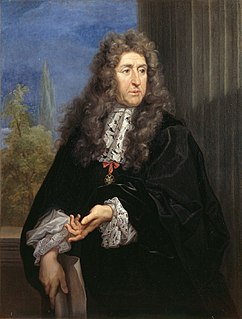 W
WAndré Le Nôtre, originally rendered as André Le Nostre, was a French landscape architect and the principal gardener of King Louis XIV of France. He was the landscape architect who designed the gardens of the Palace of Versailles, and his work represents the height of the French formal garden style, or jardin à la française.
 W
WJulien David Le Roy or Leroy was an 18th-century French architect and archaeologist, who engaged in a rivalry with Britons James Stuart and Nicholas Revett over who would publish the first professional description of the Acropolis of Athens since an early 1682 work by Antoine Desgodetz. Le Roy succeeded in printing his Ruins of the Most Beautiful Monuments of Greece four years ahead of Stuart and Revett.
 W
WFrançois Le Vau was a French Late Baroque and Neoclassical architect.
 W
WLouis Le Vau was a French Baroque architect, who worked for Louis XIV of France. He was an architect that helped develop the French Classical style in the 17th Century.
 W
WClaude-Nicolas Ledoux was one of the earliest exponents of French Neoclassical architecture. He used his knowledge of architectural theory to design not only domestic architecture but also town planning; as a consequence of his visionary plan for the Ideal City of Chaux, he became known as a utopian. His greatest works were funded by the French monarchy and came to be perceived as symbols of the Ancien Régime rather than Utopia. The French Revolution hampered his career; much of his work was destroyed in the nineteenth century. In 1804, he published a collection of his designs under the title L'Architecture considérée sous le rapport de l'art, des mœurs et de la législation. In this book he took the opportunity of revising his earlier designs, making them more rigorously neoclassical and up to date. This revision has distorted an accurate assessment of his role in the evolution of Neoclassical architecture. His most ambitious work was the uncompleted Royal Saltworks at Arc-et-Senans, an idealistic and visionary town showing many examples of architecture parlante. Conversely his works and commissions also included the more mundane and everyday architecture such as approximately sixty elaborate tollgates around Paris in the Wall of the General Tax Farm.
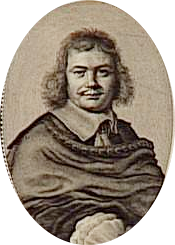 W
WAntoine Lepautre or Le Pautre (1621–1679) was a French architect and engraver. Born in Paris, he was the brother of the prolific and inventive designer-engraver Jean Lepautre. Antoine Lepautre has been called " "one of the most inventive architects of the early years of Louis XIV's reign". He was a protégé of Cardinal Mazarin, to whom he dedicated his Desseins de plusieurs palais, in which his imagination is given free rein.
 W
WJules Hardouin-Mansart was a French Baroque architect and builder whose major work included the Place des Victoires (1684–1690); Place Vendôme (1690); the domed chapel of Les Invalides (1690), and the Grand Trianon of the Palace of Versailles. His monumental work was designed to glorify the reign of Louis XIV of France.
 W
WPierre II Mignard was a French architect and painter. He was the son of painter Nicolas Mignard and the younger brother of Paul Mignard, a portrait painter.
 W
WRichard Mique was a neoclassical French architect born in Lorraine. He is most remembered for his picturesque hamlet, the Hameau de la Reine — not particularly characteristic of his working style — for Marie Antoinette in the Petit Trianon gardens within the estate of Palace of Versailles.
 W
WClaude Mollet, premier jardinier du Roy — first gardener to three French kings, Henri IV, Louis XIII and the young Louis XIV — was a member of the Mollet dynasty of French garden designers in the seventeenth century. His father was Jacques Mollet, gardener at the château d'Anet, where Italian formal gardening was introduced to France and where Claude apprenticed, and his son was André Mollet, who took the French style to Holland, Sweden and England.
 W
WPierre-Louis Moreau-Desproux was a pioneering French neoclassical architect.
 W
WFrançois d'Orbay (1634–1697) was a French draughtsman and architect who worked closely with Louis Le Vau and Jules Hardouin Mansart.
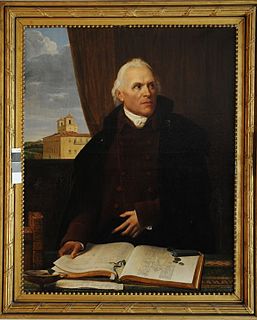 W
WPierre-Adrien Pâris was a French architect, painter and designer.
 W
WClaude Perrault was a French architect, best known for his participation in the design of the east façade of the Louvre in Paris. He also achieved success as a physician and anatomist, and as an author, who wrote treatises on physics and natural history.
 W
WJean-Rodolphe Perronet was a French architect and structural engineer, known for his many stone arch bridges. His best known work is the Pont de la Concorde (1787).
 W
WMarie-Joseph Peyre was a French architect who designed in the Neoclassical style.
 W
WNicolas de Pigage was a French builder.
 W
WMichel-Jean Sedaine was a French dramatist and librettist, especially noted for his librettos for opéras comiques, in which he took an important and influential role in the advancement of the genre from the period of Charles-Simon Favart to the beginning of the Revolution.
 W
WJacques-Germain Soufflot was a French architect in the international circle that introduced neoclassicism. His most famous work is the Panthéon in Paris, built from 1755 onwards, originally as a church dedicated to Saint Genevieve.
 W
WCharles de Wailly was a French architect and urbanist, and furniture designer, one of the principals in the Neoclassical revival of the Antique. His major work was the Théâtre de l'Odéon for the Comédie-Française (1779–82). In his designs, de Wailly showed a predilection for the perfect figure, the circle.